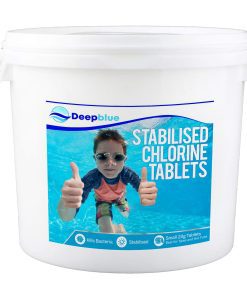-
×
 Deep Blue Pro - Mini 20g STABILISED Chlorine Tablets 5 kg SLOW RELEASE
1 ×
Deep Blue Pro - Mini 20g STABILISED Chlorine Tablets 5 kg SLOW RELEASE
1 ×£35.68£28.54
Subtotal: £28.55
Water testing stands as an essential procedure which protects users’ health together with their comfort levels and maintains proper pool sanitation. It also plays a significant role in:
Removing contamination
Protecting plant and pool surroundings
Controlling chemical usage
The improper testing of water results in health problems among bathers together with skin discomfort and problems with pool maintenance. Regular testing needs to happen with strict adherence to a predetermined schedule.
A pool testing schedule presented in the booklet requires regular examination of various water quality parameters.
Chlorine functions as the standard disinfectant which needs both free and total chlorine level monitoring. Free chlorine functions as a bacterial eradication agent yet combined chlorine indicates the formation of disinfection byproducts.
When using chlorine disinfection in UK swimming pools operators should maintain free chlorine at 1.0 mg/L or reduce it to 0.5 mg/L when using UV or ozone systems.
Hot tubs and spas use bromine as a disinfectant because of its superior performance at high temperatures and pH conditions. Bromine presents fewer adverse effects on human skin and eyes when compared to chlorine.
The disinfection system uses PHMB in conjunction with Hydrogen Peroxide as its main disinfecting agents.
Ozone functions as a powerful disinfectant which kills chlorine-resistant pathogens effectively. The system enables free chlorine concentrations at lower levels.
pH represents the measure of water acidity and alkalinity while affecting both disinfectant performance and bather comfort levels. The recommended pH level should maintain between 7.2 and 7.4.
Total Alkalinity: Acts as a pH buffer, preventing drastic fluctuations.
Cyanuric Acid (Stabilizer): The compound protects chlorine from sunlight degradation which makes it suitable for outdoor pool applications.
Calcium Hardness determines how water tends to dissolve or precipitate minerals from its composition. Pool surfaces become damaged when calcium hardness levels are too low yet scaling occurs when they reach excessive heights.
Phosphate: Promotes algae growth and requires careful monitoring, especially in outdoor pools.
Dissolved Solids: High levels indicate decreasing water quality. The solution requires dilution because the measured concentration exceeds the permitted range.
Salinity: Relevant for saltwater chlorination systems. Through the process of electrolysis salt transforms into chlorine-based sanitizers.
Turbidity: Measures water clarity. Good visibility results from low turbidity values which demonstrate both effective filtration and water chemistry management.
Water Balance: A complex interplay of calcium hardness, total alkalinity, and pH. The water’s properties determine whether it will develop scaling deposits or become corrosive.
The absence of dangerous pathogens depends on conducting regular microbiological testing for pool water. The analysis includes colony count along with tests for coliforms including E. coli and Pseudomonas Aeruginosa which should be performed by accredited laboratories.
The frequency of testing depends on pool usage patterns as well as local regulatory requirements. Generally:
Daily: Disinfectant residual and pH
Weekly: Alkalinity, calcium hardness, cyanuric acid, water balance, and total dissolved solids
Monthly: Turbidity and microbiological testing
The booklet presents different testing approaches with their respective benefits and drawbacks:
Test strips represent a basic and economical method although their readings serve as indications only.
Colorimetric Methods: Utilize reagent-induced color changes for analysis. Human interpretation of the comparator system produces better results than test strips do.
Photometers: Digital color change analysis through these devices delivers precise results and supports data storage features.
Electrochemical Methods: Used for measuring pH, TDS, and conductivity with high accuracy.
Turbidity Meters: These instruments serve to measure turbidity at levels which human eyes cannot detect.
The booklet emphasizes best practices for accurate and reliable testing, including:
Using clean equipment and fresh reagents
Adhering strictly to test procedures
Diluting samples for out-of-range results
Maintaining and calibrating instruments
The process requires collecting water samples from different areas across the pool for proper representation.
Regular and meticulous water testing is the cornerstone of safe and enjoyable pool operation. Understanding the key parameters, testing methods, and best practices ensures optimal water quality, protects bathers’ health, and extends the lifespan of pool equipment.
Some products you might be interested in:

Please enter your details below to save your trolley for later. If you have any questions please leave your email address and we will provide a swift response.